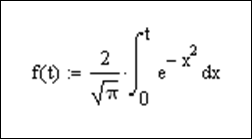17.2: Symbolics
- Page ID
- 15021
Here we look at many of the other capabilities of the symbolic toolbar. The “solve” button was discussed in a previous chapter.
Example 17.2.1
- Expand \((x+ 2)^4\),
- factor \(x^3 + 3x^2 + 3x+ 1\),
- find the Taylor polynomial of order 8 for \(\cos x\),
- find the partial fraction expansion of \(1/(x^3 − x)\), and
- find the Laplace transform of \(t^2 − 1\).
Solution
In each case, we enter the expression, select the button from the symbolic toolbar, make any alterations (like in the Taylor polynomial question - adding the comma and 8) and click outside the expression
\[\left ( x+2 \right )^{4} expand\rightarrow x^{4}+8x^{3}+24x^{2}+32x+16\nonumber\]
\[x^{3}+3.x^{2}+3.x+1 factor\rightarrow (x+1)^{3}\nonumber\]
\[\cos(x) series, 8\rightarrow 1-\frac{x^{2}}{2}+\frac{x^{4}}{24}-\frac{x^{6}}{720}\nonumber\]
\[\frac{1}{x^{3}-1} parfac\rightarrow \frac{1}{2(x-1)}-\frac{1}{x}+\frac{1}{2(x+1)}\nonumber\]
\[t^{2}-1 laplace\rightarrow -\frac{s^{2}-2}{s^{3}}\nonumber\]
In the next example, we point out the difference between symbolic evaluation and approximation.
Example 17.2.2: The Error Function
The error function f(t) comes up in many applications. It is defined as

If we use the standard symbolic evaluation symbol →, then we will get the answer in terms of the built-in error function “erf”

If we instead use the evaluation equals sign (just =), we get the approximation



